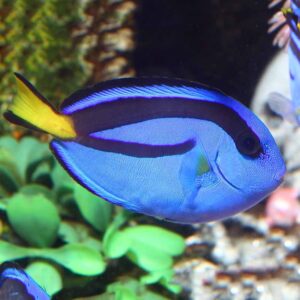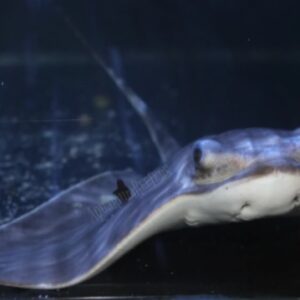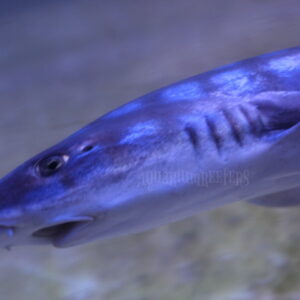Description
The Pink Spot Goby, Cryptocentrus leptocephalus, also known as Pink Speckled Shrimp Goby, is a visually striking fish with its vibrant colours and unique markings. It has a slender body with a pale white to light pink base colouration. Adorning its body are distinct pink spots, which give it its common name. At maturity, it reaches a maximum size of around 3 inches (7.6 centimetres), making it a suitable choice for smaller aquarium setups.
Natural Habitat
The Pink Spot Goby inhabits the sandy or rubble areas near coral reefs in its natural habitat. It prefers a sandy substrate, often with scattered patches of rubble and small crevices. These habitats provide the Pink Spot Goby with suitable hiding places and mimic its natural environment.
Keeping Pink Spot Goby Healthy:
Keeping the Pink Spot Goby, or Pink Speckled Shrimp Goby, healthy requires attention to its specific care needs. It has a moderate care level, making it suitable for both beginners and experienced aquarists. Maintaining stable water parameters and providing suitable hiding places within the aquarium are crucial for its well-being.
Special Requirements and Feeding
The Pink Spot Goby is a carnivorous species that feeds primarily on small invertebrates and zooplankton in the wild. In captivity, it can be fed a varied diet consisting of live or frozen foods, such as brine shrimp, mysis shrimp, and small crustaceans. Offering a combination of these foods ensures a well-rounded diet and promotes the fish’s overall health.
How Many Should I Keep?
The Pink Spot Goby is generally kept as a single individual within an aquarium due to its territorial nature. It may exhibit aggressive behaviour towards conspecifics, especially if they are of similar size. Therefore, it is recommended to keep only one Pink Spot Goby per tank.
Lighting Preference
The Pink Spot Goby thrives under moderate lighting conditions in the aquarium. It does not have specific lighting requirements and can adapt well to various lighting setups. However, providing a natural light spectrum, including both white and blue lights, can enhance the fish’s colours and create a visually appealing display.
Suitable Tank Mates
When selecting tank mates for the Pink Spot Goby, it is crucial to consider their compatibility. It is generally peaceful and can coexist with other non-aggressive species that share its water requirements. Suitable tank mates may include small gobies, blennies, and peaceful reef fish. However, caution should be exercised when introducing it to larger or more aggressive species.
Reproduction in the Wild:
The Pink Spot Goby forms monogamous pairs, with a male and female bonding together for reproduction. The male establishes a territory, often a sandy area with scattered rubble or small crevices near coral reefs. He displays vibrant colours and performs courtship displays to attract a female. Once courtship is successful, the pair engages in a delicate dance, swimming closely together.
During spawning, the female releases her eggs, and the male simultaneously releases his sperm, allowing for external fertilization.
Breeding Cryptocentrus leptocephalus in Captivity:
- Set up:
Creating the ideal breeding environment for the Pink Spot Goby involves setting up a separate breeding tank. The tank should have appropriate water parameters, including temperature, salinity, and pH, similar to the main aquarium. Adding fine sand substrate and providing hiding places, such as PVC pipes or small caves, is essential to mimic their natural spawning sites.
- Courtship/Spawning:
Courtship and spawning in the Pink Spot Goby typically begin with the male establishing a territory within the breeding tank. The male showcases vibrant colours and engages in courtship displays to attract a female. Once courtship is successful, the male and female swim in close proximity, performing a circular dance before spawning. During spawning, the female releases her eggs, and the male simultaneously fertilizes them.
- Rearing:
After spawning, it is crucial to promptly remove the adults from the breeding tank to prevent predation on the eggs. The adhesive eggs attach to the chosen substrate, such as the sand or the walls of the PVC pipe. Maintaining stable water conditions, including temperature and water quality, is vital for successful egg development. The eggs typically hatch within a week, and the larvae enter a pelagic phase, drifting in the water column.
Sexual Dimorphism:
Sexual dimorphism in the Pink Spot Goby (Pink Speckled Shrimp Goby) is not readily apparent, as both males and females share similar body shapes and colours. It is challenging to visually distinguish between the sexes without observing their courtship and spawning behaviour. During courtship, males may display more vibrant colours and engage in territorial behaviours to attract females.
Distribution:
The Pink Spot Goby, Cryptocentrus leptocephalus, is not typically available as a captive bred or line bred strain. The original fish is sourced from the wild, with its natural distribution ranging across the Western Pacific Ocean, including regions such as Indonesia and the Philippines.
Summary:
Breeding the Pink Spot Goby, sometimes called Pink Speckled Shrimp Goby, (Cryptocentrus leptocephalus), in captivity requires careful attention to their specific needs. Setting up a separate breeding tank with appropriate hiding places and water conditions is crucial. The courtship and spawning process involve male displays, egg release by the female, and simultaneous fertilization. Removing the adults and maintaining optimal water conditions are essential for successful egg development. Sexual dimorphism in this species can be challenging to discern, but observation of courtship behaviours provides insights. The Pink Spot Goby is sourced from the wild and is not commonly available as a captive bred strain. Understanding their natural breeding behaviour and requirements enables aquarists to appreciate and potentially reproduce this captivating species in the aquarium.
The Fish pictured here are representative only and the livestock you receive may vary in pattern, coloration, and shape.









Reviews
There are no reviews yet.